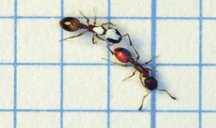Professor Ant
Certain ants can teach other ants the route to a food source.
By Emily Sohn
If you haven’t appreciated your teachers lately, now might be a good time to reflect on all that they do for you.
Good teachers already know the information that they’re teaching, but they slow down to explain it to you. With their help, you learn far faster than you would on your own. And teachers take the time to listen to your questions and steer you in the right direction.
One kind of ant does all of these things, too, a new study finds. It is, in fact, the first time that scientists have demonstrated true teaching in an animal other than humans.
 |
|
An ant (right, with red paint) that knows where food lies guides an inexperienced forager (left, dabbed with white), which keeps in touch with antenna taps. |
| Nigel R. Franks and Tom Richardson, University of Bristol |
“One would have expected to see teaching in chimpanzees or [some other primate], but for the first fairly strong evidence of it to come from ants is surprising and interesting,” says Bennett G. Galef Jr. of McMaster University in Hamilton, Ontario.
The tiny ant Temnothorax albipennis lives in small nests among the rocks on the southern coast of England. Previously, researchers had been watching how these ants go about moving to a new home. They noticed that ants that know the way either carry their buddies or run very close in front of them as guides.
The guiding behavior is interesting because ants run much faster when alone or even when carrying others.
In their lab, researchers from the University of Bristol in England worked with colonies of Temnothorax albipennis that had a sugar solution placed 15 centimeters (6 inches) away from their nests. The scientists filmed the colony’s behavior and then spent hundreds of hours analyzing the videotape.
The analyses showed that running with another ant took four times as long as running alone. So, just as teachers slow down to help you, ants were slowing down to help each other.
Follower ants also tapped their antennae on the backs of the leaders, and both ants adjusted their speeds to stay together. These behaviors indicate a communication system between teacher and student, just like the questions you ask when you’re confused.
The student ant also sometimes stopped the guided trek to turn this way and that as if it were looking for landmarks.
The true test of good teaching is whether the lessons work, and the ants passed this test with flying colors, too. With a teacher-guide, it took ants only two-thirds as long to find the sugar as it did for untaught ants to discover it on their own.
Moreover, after the lesson, student ants often managed to find their own shortcuts on the way home, a sign that they had learned the neighborhood well during their guided trip to the food. And the student ants sometimes turned into teachers themselves.
All this activity appears to pay off for Temnothorax albipennis. Through careful teaching, ants are able to get coworkers to a food source without having to lay down a scent trail, which might go unnoticed anyway.—E. Sohn
Going Deeper:
Milius, Susan. 2006. Little professor: Ants rank as first true animal teachers. Science News 169(Jan. 14):20-21. Available at http://www.sciencenews.org/articles/20060114/fob4.asp .
You can learn more about the “ant lab” at the University of Bristol at www.bio.bris.ac.uk/research/behavior/AntLab/ (University of Bristol).
Peterson, Ivars. 2000. Ant math. Science News for Kids (December). Available at www.sciencenewsforkids.org/pages/puzzlezone/
muse/muse1200.asp .
Sohn, Emily. 2006. Young ants in the kitchen. Science News for Kids (Jan. 4). Available at http://www.sciencenewsforkids.org/articles/20060104/Note3.asp .







